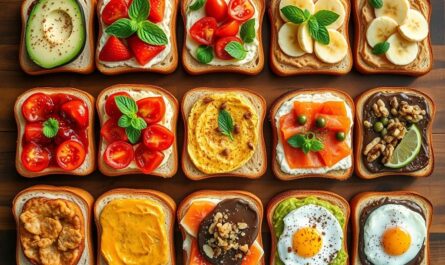Top 10 Healthiest Foods You Should Include in Your Diet
In a world full of fast food and ultra-processed meals, it’s easy to forget the incredible power of real, wholesome food. What we eat affects everything—from our energy levels to our immune system, mood, and even longevity. A healthy diet isn’t about strict restrictions but about balance, variety, and nourishment.
If you’re ready to eat smarter, feel better, and improve your overall health, start with this list of the Top 10 Healthiest Foods You Should Include in Your Diet. These nutrient-rich foods offer countless benefits and can easily become staples in your daily meals.
1. Leafy Green Vegetables
Examples: Spinach, Kale, Swiss chard, Collard greens
Leafy greens are nutritional powerhouses packed with fiber, iron, calcium, and vitamins A, C, and K. They’re low in calories but extremely high in antioxidants, helping reduce inflammation and support heart and brain health.
How to include them:
- Add to smoothies, salads, soups
- Sauté with garlic and olive oil
2. Berries
Examples: Blueberries, Strawberries, Raspberries, Blackberries
Berries are loaded with antioxidants, particularly anthocyanins, which fight oxidative stress and may reduce the risk of heart disease and certain cancers. They’re also high in fiber and vitamin C.
How to include them:
- Use in smoothies
- Top yogurt or oatmeal
- Eat as a healthy snack
3. Fatty Fish
Examples: Salmon, Mackerel, Sardines, Tuna
Fatty fish are rich in omega-3 fatty acids, essential for brain function, reducing inflammation, and lowering the risk of chronic diseases like heart disease. They also provide high-quality protein and vitamin D.
How to include them:
- Grill, bake, or pan-fry
- Add canned tuna or sardines to salads
4. Nuts and Seeds
Examples: Almonds, Walnuts, Chia seeds, Flaxseeds, Pumpkin seeds
Despite being calorie-dense, nuts and seeds are loaded with healthy fats, plant-based protein, fiber, vitamins, and minerals. They promote heart health, reduce inflammation, and support brain function.
How to include them:
- Snack on them
- Sprinkle on salads or oatmeal
- Blend into smoothies
5. Whole Grains
Examples: Oats, Quinoa, Brown rice, Barley, Millet
Whole grains are a great source of complex carbohydrates, fiber, and essential nutrients like magnesium and B vitamins. They help manage blood sugar levels, support digestion, and improve heart health.
How to include them:
- Replace white rice or pasta with brown rice or quinoa
- Enjoy oatmeal for breakfast
- Use whole grain bread
6. Legumes
Examples: Lentils, Chickpeas, Black beans, Kidney beans, Peas
Legumes are rich in plant-based protein, fiber, iron, and folate. They help maintain healthy cholesterol levels, aid digestion, and are especially beneficial for vegetarians and vegans.
How to include them:
- Add to salads, soups, and curries
- Blend into hummus and bean spreads
7. Cruciferous Vegetables
Examples: Broccoli, Cauliflower, Brussels sprouts, Cabbage
Cruciferous vegetables are packed with compounds like glucosinolates, which have cancer-fighting properties. They also offer fiber, vitamins C and K, and folate.
How to include them:
- Steam, roast, or stir-fry
- Add to soups and grain bowls
8. Garlic and Onions
These allium vegetables offer powerful anti-inflammatory, antibacterial, and antiviral benefits. Garlic contains allicin, known to help lower blood pressure and cholesterol levels.
How to include them:
- Use fresh garlic and onions as a base for cooking
- Incorporate into soups, stews, stir-fries, and dressings
9. Greek Yogurt
Greek yogurt is a great source of probiotics, calcium, and high-quality protein. It supports gut health, boosts metabolism, and strengthens bones.
How to include it:
- Eat plain or with fruit and honey
- Use as a healthy alternative to sour cream or mayo
10. Avocados
Avocados are rich in monounsaturated fats, which are heart-healthy and anti-inflammatory. They also contain potassium, fiber, and several key vitamins.
How to include them:
- Mash on toast
- Slice into salads
- Blend into smoothies
- Use as a creamy base for dressings
Bonus Tips for Eating Healthier
- Balance is key: Include a mix of macronutrients (protein, fats, carbs) and micronutrients in each meal.
- Eat the rainbow: A variety of colors ensures a range of nutrients.
- Stay hydrated: Water is just as crucial as solid food in a healthy diet.
- Limit processed food: Choose fresh, whole ingredients when possible.
Sample Healthy Day Using These Foods
- Breakfast: Greek yogurt with berries, chia seeds, and honey
- Lunch: Quinoa salad with chickpeas, cherry tomatoes, leafy greens, and a lemon-garlic dressing
- Snack: A handful of almonds and an apple
- Dinner: Grilled salmon with steamed broccoli and brown rice
Incorporating these Top 10 Healthiest Foods into your diet doesn’t mean sacrificing taste or convenience. These delicious and versatile options can easily become part of your everyday meals, giving your body the fuel it needs to function at its best.
Remember, health is not about perfection—it’s about making smarter choices one meal at a time. Start small, stay consistent, and enjoy the benefits of real, nutritious food.
